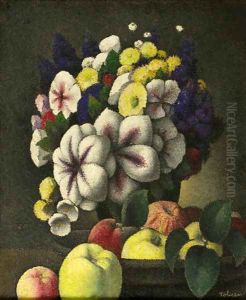Felix-Elie Tobeen Paintings
Félix-Elie Tobeen, born Elie Bonnet in Bordeaux, France, in 1880, was a French painter associated with the Fauvist movement, yet his work also transcends into a unique blend of regionalism and modernism, particularly reflecting the influence of the Basque culture and landscapes. Tobeen's journey in art began in his hometown but eventually led him to Paris, where he became part of the vibrant art scene in the early 20th century. It was during this period that he adopted the pseudonym 'Tobeen,' a nod to his personal and artistic reinvention.
In Paris, Tobeen was exposed to the groundbreaking works of the Fauves, artists like Henri Matisse and André Derain, whose bold use of color and brushwork left a lasting impact on him. Despite this influence, Tobeen's artistry did not linger long in the pure Fauvist realm. He was drawn to the Basque region in the southwest of France, where he ultimately settled. This move marked a significant shift in his artistic focus. The culture, people, and landscapes of the Basque country infused his work with a distinct character, merging Fauvist techniques with a more figurative and regionalist approach. His paintings often depicted local scenes, traditions, and daily life, imbued with vibrant colors and dynamic compositions that reflected both his Fauvist leanings and a deep connection to his adopted homeland.
Tobeen's contribution to art, however, extends beyond his paintings. He was also known for his woodcuts and engravings, which further demonstrate his versatility and keen eye for detail. Despite his talent and the unique niche he carved for himself within the art world, Tobeen remained relatively obscure compared to his contemporaries. His works were exhibited in several notable venues, including the Salon des Indépendants and the Salon d'Automne in Paris, yet he never achieved the same level of fame as some of his Fauvist counterparts.
Félix-Elie Tobeen passed away in 1938, leaving behind a body of work that, while not widely recognized in the annals of art history, offers a compelling glimpse into the fusion of early 20th-century modernist movements with the rich cultural tapestry of the Basque region. Today, his paintings are appreciated for their unique blend of color, form, and regional representation, securing Tobeen's place as a noteworthy figure in the transition from Fauvism to expressions of regional identity within modern art.
